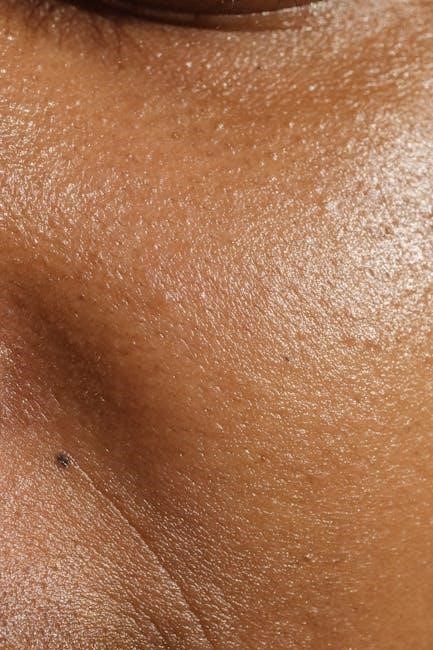Guided Tissue Regeneration (GTR) is a surgical technique designed to repair damaged periodontal tissues and promote bone regeneration, utilizing resorbable barriers to prevent tissue overgrowth, thus enhancing healing outcomes in dental surgeries.
1.1 Definition and Purpose of GTR
Guided Tissue Regeneration (GTR) is a surgical procedure that utilizes biocompatible barriers to direct the growth of specific tissues, such as bone and periodontal ligament, in areas of periodontal defects. The primary purpose of GTR is to regenerate lost or damaged tissues, restoring functional anatomy and improving oral health. Resorbable barriers play a key role in this process by preventing the infiltration of unwanted soft tissue into the defect, allowing preferred cells to populate the area. These membranes are designed to promote healing while minimizing the need for additional surgeries. GTR is particularly effective in treating defects caused by periodontal disease or trauma, offering a targeted approach to tissue repair and regeneration.
1.2 Historical Development of GTR Techniques
The concept of Guided Tissue Regeneration (GTR) emerged in the 1980s, evolving from experimental studies on periodontal wound healing. Initial techniques utilized non-resorbable barriers to prevent soft tissue invasion into defects. The introduction of resorbable membranes in the 1990s marked a significant advancement, eliminating the need for membrane removal surgeries. Researchers like Nyman et al. pioneered early GTR applications, demonstrating its potential in periodontal reconstruction. Over time, advancements in biomaterials, such as collagen and synthetic polymers, improved membrane design and biocompatibility. These innovations have refined GTR techniques, enhancing predictability and patient outcomes in periodontal and bone regeneration therapies. The historical progression of GTR underscores its adaptability and scientific evolution, aligning with modern dental surgical practices.

Resorbable Barriers in GTR
Resorbable barriers in GTR are biocompatible membranes designed to dissolve over time, eliminating the need for removal and promoting controlled tissue regeneration in periodontal defects.
2.1 Advantages of Resorbable Membranes
Resorbable membranes in GTR offer significant advantages, including biocompatibility, elimination of removal surgery, and reduced risk of complications. They integrate naturally with tissue, promoting regeneration without foreign body reactions. Their gradual resorption allows for controlled healing, minimizing patient discomfort and optimizing surgical outcomes. Additionally, these membranes reduce the need for multiple procedures, lowering overall treatment costs and improving patient compliance. Their ability to act as a temporary barrier ensures that soft tissue does not encroach on the healing area, facilitating targeted bone and periodontal regeneration effectively.
2.2 Materials Used for Resorbable Barriers
Resorbable barriers in GTR are typically made from biocompatible materials such as polylactic acid (PLA), polyglycolic acid (PGA), and their copolymers. These materials are chosen for their ability to degrade naturally in the body, eliminating the need for membrane removal. Collagen-based membranes are also widely used due to their excellent biocompatibility and ability to promote tissue integration. Additionally, hydroxyapatite and chitosan-based materials are employed for their osteoconductive properties, enhancing bone regeneration. These materials are designed to provide a temporary barrier that resorbs over time, allowing for controlled tissue healing. Their biodegradability ensures a seamless integration with the body’s natural processes, making them ideal for guided tissue regeneration applications.

Guided Bone Regeneration (GBR)
Guided Bone Regeneration (GBR) is a surgical procedure utilizing resorbable barriers to promote new bone growth in deficient areas, enhancing dental implant placement and bone grafting outcomes.
3.1 Role of Resorbable Membranes in GBR
Resorbable membranes play a pivotal role in Guided Bone Regeneration (GBR) by acting as biocompatible barriers that prevent the infiltration of soft tissue into bone defects. These membranes are designed to maintain space for bone regeneration and promote osteogenesis. Composed of materials like polylactic acid or collagen, they gradually degrade over time, eliminating the need for a second surgical procedure to remove them. This feature enhances patient comfort and reduces recovery time. The membranes also provide a scaffold for cell proliferation and differentiation, ensuring that bone tissue can grow effectively. By controlling the healing process, resorbable membranes significantly improve the predictability and success of GBR procedures, particularly in dental implantology and periodontal surgery.
3.2 Clinical Applications of GBR
Guided Bone Regeneration (GBR) is widely applied in dental implantology and periodontal surgery to address bone deficiencies. Its primary clinical use is in cases of insufficient bone volume, such as for dental implant placement or repairing periodontal defects. Resorbable barriers are particularly effective in these scenarios, as they promote bone healing without requiring membrane removal. GBR is also utilized to enhance bone grafting outcomes, ensuring optimal integration of graft materials. Additionally, it is employed in treating failing dental implants by improving bone density around implant sites. The technique is highly effective in restoring bone structure, enabling successful implant placement and long-term stability. Its applications extend to various oral surgical procedures, making it a versatile tool in modern dentistry for achieving predictable and successful bone regeneration outcomes.

Design and Function of Resorbable Barriers
Resorbable barriers are designed from biocompatible materials like collagen or synthetic polymers, ensuring gradual degradation while providing a protective framework for tissue regeneration and bone growth.
4.1 Membrane Architecture and Biocompatibility
Resorbable barriers in guided tissue regeneration are crafted with specific architectural features to ensure optimal biocompatibility and functionality. These membranes are typically designed with porous structures that facilitate tissue integration while preventing the ingress of unwanted cells. Materials such as collagen, polylactic acid (PLA), and polygalactic acid (PGA) are commonly used due to their ability to integrate seamlessly with human tissue. The biocompatibility of these materials is crucial, as they must not elicit adverse immune responses or cause inflammation. Additionally, the membrane’s texture and pore size are carefully engineered to promote cell adhesion and proliferation, which are essential for effective tissue regeneration. The gradual resorption rate of these barriers ensures that they provide temporary support without leaving permanent foreign substances in the body, thus enhancing the overall healing process.
4.2 Mechanism of Action in Tissue Regeneration
The mechanism of action of resorbable barriers in guided tissue regeneration revolves around their ability to create a protected environment for healing. Upon placement, these barriers physically block the migration of soft tissue cells into the defect, allowing preferred cells such as osteoblasts and periodontal ligament fibroblasts to populate the area. The membrane’s porous structure facilitates the exchange of nutrients and waste products, maintaining a conducive environment for regeneration. Over time, the barrier degrades naturally, coinciding with the progression of tissue repair. This synchronized process ensures that the regenerated tissue is healthy and functional, without the need for secondary surgical procedures to remove the membrane. The resorption rate is calibrated to match the healing timeline, thereby optimizing the overall regenerative outcome.

Clinical Outcomes and Efficacy
Resorbable barriers in GTR demonstrate high success rates in periodontal surgery, promoting long-term stability of bone and tissue regeneration, with minimal complications and reduced need for secondary procedures.
5.1 Success Rates in Periodontal Surgery
Resorbable barriers in guided tissue regeneration (GTR) have shown high success rates in periodontal surgery, with significant bone fill and attachment gain observed in numerous clinical studies. These barriers effectively prevent soft tissue infiltration, allowing bone and periodontal ligament regeneration. Studies report an average bone fill of 70-90% in defects treated with resorbable membranes, with long-term stability of clinical outcomes. The use of materials like polylactic acid and collagen has further enhanced predictability, minimizing complications. Additionally, resorbable barriers reduce the need for membrane removal, lowering patient morbidity; Overall, their efficacy in promoting periodontal regeneration makes them a preferred choice in modern surgical practices.
5.2 Case Studies and Long-Term Results
Several case studies highlight the effectiveness of resorbable barriers in guided tissue regeneration, demonstrating significant bone regeneration and tissue healing. A study using the Guidor® Matrix Barrier reported successful periodontal regeneration in defects with a follow-up of 12 months. Similarly, long-term results from procedures using polylactic acid membranes showed stable clinical outcomes, with minimal complications. Resorbable barriers have also proven effective in implant-related bone defects, enhancing graft integration and reducing the need for additional surgeries. These studies underscore the reliability of resorbable membranes in promoting durable tissue repair, with patient follow-ups extending up to 5 years showing consistent bone fill and soft tissue stability. The use of bioactive materials further enhances these outcomes, ensuring long-term success in periodontal and bone regeneration procedures.


